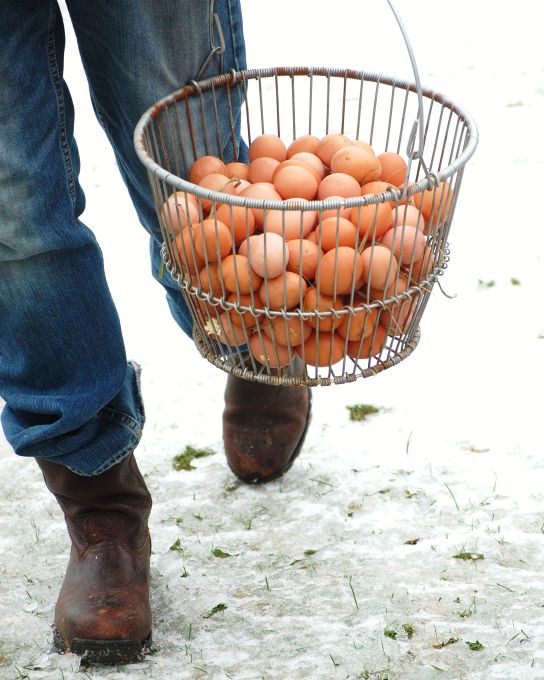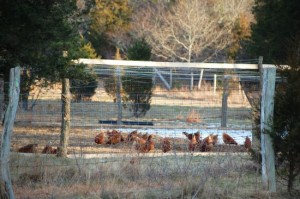 Four years ago, Roy and I (newly besotted), rented a little plot of land on a Vineyard farm. We grew vegetables and sold them at the farm’s roadside stand. Living in a tiny apartment over a general store, we shuttled back and forth to tend our plot.
Four years ago, Roy and I (newly besotted), rented a little plot of land on a Vineyard farm. We grew vegetables and sold them at the farm’s roadside stand. Living in a tiny apartment over a general store, we shuttled back and forth to tend our plot.
That fall, our friend Joannie tracked us down one day, took us by the hand, and led us to a little farm house on two acres of land. Right on the spot, she introduced us to the owners and insisted that they rent the farm house to us. I’m not sure if the owners knew what hit them, but in about an hour, we had all shaken hands and Roy and I were packing up the apartment. Our new landlords said, “Sure, grow whatever you want here.”
We moved into the little (uninsulated) 1895 farm house a few weeks later, and by spring we were turning over the soil and putting up the fences for our first vegetable plot. Roy built a little farm stand, and we stuck a sign out by the road. One summer, then two summers went by. We got 8 laying hens, and then 50 more. The garden doubled in size, and we built a hoop house. We made a tiny bit of money off our tiny farmette, keeping the farm stand open almost every day while writing books and building houses (our real jobs), too.
Then one day Tom came by. Tom and Roy talked, like men do, standing next to their trucks, arms folded. I watched from the kitchen window, my hands covered in olive oil and salt. Tom and Roy walked down to the fence line at the bottom of the farmette and looked out over the fields beyond, fields that have been in Tom’s family for hundreds of years. Tom and his mother Druscilla (yes, our landlords) lease some of that land to Morning Glory Farm to grow corn and squash. But there are eight grassy acres spiked with pines and cedars right behind us that long to be farmed.
 After a spell, Roy and Tom walked back up to the house. I wiped my hands and stepped outside. “We’re going to be chicken farmers, dear,” Roy informed me, Tom smiling beside him. They’d made a deal.
After a spell, Roy and Tom walked back up to the house. I wiped my hands and stepped outside. “We’re going to be chicken farmers, dear,” Roy informed me, Tom smiling beside him. They’d made a deal.
At that moment, our fuzzy dream snapped into focus and took on the shape of reality.
With the extra acres Tom would lease us (four to start), we’d be able to turn the farm into a real business. Roy knew he wanted to spend less time on big building projects and more time farming, and we knew from a bit of number crunching that laying hens would be profitable. We played the numbers out a bit more and decided to make a phone call. To our surprise, we hung up the phone with (gulp) an order of 200 16-week old pullets scheduled to be delivered to the island in only a few weeks time. That was late October.
While Roy and our friend Scott quickly built the new coops and erected the huge (60′ x 90′) initial yard for the pullets, I worked up a real business plan, shopped around for insurance, filed the LLC paperwork, got a Tax ID number—and ordered a whole lot more egg cartons!
 Since the day the pullets arrived, Roy has worked feverishly to get all the systems in place—watering and feeding, cleaning the coops, haying the nest boxes, collecting the eggs, washing the eggs, packaging the eggs, marketing the eggs, delivering the eggs. He is Mr. Egg Man. (I have been conveniently “on deadline,” though I am told that when the next 200 chickens arrive this spring, my duties will be, ahem, changing.)
Since the day the pullets arrived, Roy has worked feverishly to get all the systems in place—watering and feeding, cleaning the coops, haying the nest boxes, collecting the eggs, washing the eggs, packaging the eggs, marketing the eggs, delivering the eggs. He is Mr. Egg Man. (I have been conveniently “on deadline,” though I am told that when the next 200 chickens arrive this spring, my duties will be, ahem, changing.)
 Mr. Egg Man and I are celebrating today, celebrating the end of our first real week in business. All our paperwork is complete. Nearly all of the pullets are laying, and Roy collected more than 1300 eggs this week. We have new customers—a restaurant, a grocery store, and a market; the farm stand cooler is stocked every day. Best of all, not a single one of those 1300 eggs is left in the fridge. All sold. Today, there will be 18 dozen more to pack up. And 18 dozen more tomorrow. Whew. Well, you can’t have a farm business without a farm product. Which is why I am off to transplant lettuce seedlings in the hoop house. This is the coolest part about the dream—coloring in the lines you’ve sketched for yourselves.
Mr. Egg Man and I are celebrating today, celebrating the end of our first real week in business. All our paperwork is complete. Nearly all of the pullets are laying, and Roy collected more than 1300 eggs this week. We have new customers—a restaurant, a grocery store, and a market; the farm stand cooler is stocked every day. Best of all, not a single one of those 1300 eggs is left in the fridge. All sold. Today, there will be 18 dozen more to pack up. And 18 dozen more tomorrow. Whew. Well, you can’t have a farm business without a farm product. Which is why I am off to transplant lettuce seedlings in the hoop house. This is the coolest part about the dream—coloring in the lines you’ve sketched for yourselves.

Great post, Susie! Congratulations! And love your closing line. You rock!
Susie and Roy – you two are so amazing! Congratulations!
Thanks Molly — so do you!! Love the stew article and cover photo…yum
Thanks Nancy — better the hen house than the nut house!!
Thanks Don. Hope you’re enjoying your travels.
Cheers, to you and Roy Susie! I hope one day I’ll get to eat some of those eggs one day.
Susie, the best part of the story: “…not a single one of those 1300 eggs is left in the fridge.”. Marketing (such as it is) and a quality product and knowing one’s supplier is key. Your hard work is certainly paying off.
No competition there on the island?
Thanks Kathy. Yes, plenty of (friendly!) competition but the demand for local eggs is high and has not yet been met with enough supply!!
Happy new year Lori!